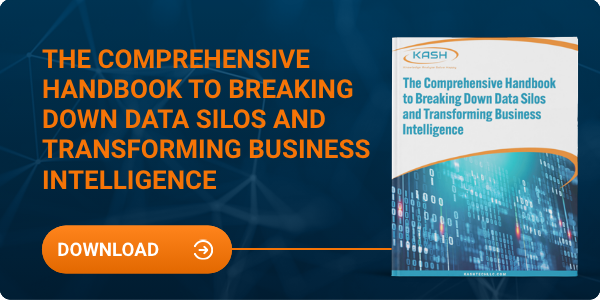Why Your Business Needs Data Transformation to Achieve Impactful Growth
Topic:
Data Silos
In your quest for a data-driven culture—i.e., making critical business decisions based on facts, not just gut feelings—you need quality data. The data must serve the systems and the people who need it to run their part of the business. Systems need the flow of raw data, but people need the context and format that comes from processes involved in data integration and, where necessary, data transformation.
Data transformation makes the data usable, understandable, and accurate. Processes such as data integration, data migration, data warehousing, and data wrangling may involve data transformation. This article on integrating multiple data sources highlighted several approaches to data integration. Those approaches are the first steps in using data to make business decisions based on the best analytics.
You must have transformed and integrated the data to perform analytics. The analytics will tell you about your business's problems and opportunities, which will help you grow.
About this Post
This post focuses on why data transformation is a critical process in processing the flow of vital business information. The goal is to transform all that data through processes that convert eclectic information and work products into a resource that can be curated, calculated, and reported for discovering trends and making the best business decisions.
We will discuss the following:
- Why data transformation is vital to your business processes
- The 12 components of data transformation
- Challenges of data transformation
- The bottom-line benefits of data transformation
What is Data Transformation?
Data Transformation is part of an enterprise data and analytics initiative to support the decision-making process of diverse audiences across the organization. It is often the process of converting data from one or more sources into a new source that is cleansed, validated, and in an easy-to-use format for analytics consumption.
Types of Data Transformation
In addition to consumption by people and uses for analytics, the product of data transformation can also be piped into other systems. Data transformation may be:
- constructive (adding, copying, and replicating data)
- destructive (deleting fields and records)
- aesthetic (standardizing salutations or street names)
- structural (renaming, moving, and combining columns in a database)
Why is Data Transformation Important?
Often, before data can be shunted to users who need it most, it must be transformed. For example, medical facilities need to transmit data from their systems to other systems or parties. The format of the data may be useful for informational purposes, but not for analysis. So, to perform analytics, the data needs to be transformed before it can be incorporated into a database.
Data transformation is the process of converting data from one or more sources into a new source that is cleansed, validated, and in an easy-to-use format for analytics consumption.
For data analytics projects, data may be transformed at stages of the data pipeline. For example, organizations that use on-premises data warehouses generally use an ETL (extract, transform, load) process, in which data transformation is the intermediate step.
This intermediate step means that data transformation:
- is part of an enterprise data and analytics initiative to support the decision-making process of diverse audiences across the organization
- is the process of converting data from one or more sources into a new source that is cleansed, validated, and in an easy-to-use format for analytics consumption
- can also transform data so that other systems can use it
Finally, data transformation may be one or a combination of the following four approaches:
- constructive (adding, copying, and replicating data)
- destructive (deleting fields and records)
- aesthetic (standardizing salutations or street names),
- structural (renaming, moving, and combining columns in a database)
The foregoing approaches are included elements of the 12 components of data transformation described in the next section.
The 10 Components of Data Transformation
Data transformation consists of the following enhancements/components:
-
Redefining the Data Fields
In the example cited above, the healthcare data may have a patient name as “pat_name,” or no label. The label must be defined and placed in the proper location in the database. -
Changing Data Types
For example, a data field arrives as a text field, but to use the data, it must be transformed into a date field. Data Transformation can reshape data without changing content. This includes casting and converting data types for compatibility, adjusting dates and times with offsets and format localization, and renaming schemas, tables, and columns for clarity. -
Enhancing the Data
Transformation can enhance business data by:
- adding calculations or plugging in calculators to the data to enhance it
- Integrating other fields and enhancing/joining the data as part of the new dataset -
Enriching the Data
If there is missing data, but there is a reference point based on the data that came in, the missing data can be traced and added to form a new data set. For example, if the data comes in as a code, the code can be converted to plain English to make it more user-friendly. -
Validating the Data
During the transformation, suspicious data can be flagged and corrected through a data quality-control process. -
Extraction and Parsing
Initial transformations focus on shaping the format and structure of data. This ensures data compatibility with the destination. Parsing fields from a comma-delimited file for loading to a relational database is an example of extraction and parsing. -
Translation and Mapping
Some of the most basic data transformations involve the mapping and translation of data. For example, a column containing numbers representing error codes can be mapped to the relevant error descriptions. This makes the column more user-friendly in a customer-facing application. -
Filtering, Aggregation, and Summarization
Data transformation can reduce the amount of data and make it more manageable. For example, data can be consolidated by filtering out unnecessary fields, columns, and records. Data might also be aggregated or summarized by transforming a time series of customer transactions into hourly or daily sales counts. A customer’s transactions can be rolled up into a grand total and added to a customer information table for quicker reference or for use by customer analytics systems. -
Enrichment
Data from different sources can be merged to create denormalized, enriched information. Long or freeform fields can be split into multiple columns, and missing values can be replaced as a result of these kinds of transformations. -
Anonymization and Encryption
Data containing personally identifiable information or other information that could compromise privacy or security can be anonymized or encrypted before propagation.
Challenges of Data Transformation
Data transformation must include rules that define the actions and changes taken on data. Companies must define, document, and put governance in the rules for consistency and accuracy. A large company will be doing different things in different locations, creating inconsistent information across the organization.
Data transformation can be expensive. The cost depends on the specific infrastructure, software, and tools used to process data. Expenses may include licensing, computing resources, and hiring necessary personnel.
Data transformation processes can be resource-intensive. Performing transformations in an on-premises data warehouse after loading or transforming data before feeding it into applications can create a computational burden that slows down other operations.
Finally, a lack of expertise and carelessness can introduce problems during transformation. Data analysts without appropriate subject matter expertise are less likely to notice typos or incorrect data because they are less familiar with the range of accurate and permissible values. For example, someone working on medical data who is unfamiliar with relevant terms might fail to flag disease names that should be mapped to a singular value or notice misspellings.
Benefits of Data Transformation
Data transformation can increase the efficiency of analytic and business processes and enable better data-driven decision-making because:
- Data is transformed to make it better organized. Transformed data may be easier for both humans and computers to use.
- Properly formatted and validated data improves the data quality and protects applications from potential issues such as null values, unexpected duplicates, incorrect indexing, and incompatible formats.
- Data transformation facilitates compatibility between applications, systems, and types of data. Data used for multiple purposes may need to be transformed in different ways.
Learn how your organization can begin or continue its journey to develop a data-cleansing strategy. Download our eBook, “Breaking Down Data Silos & Transforming Business Intelligence.”

